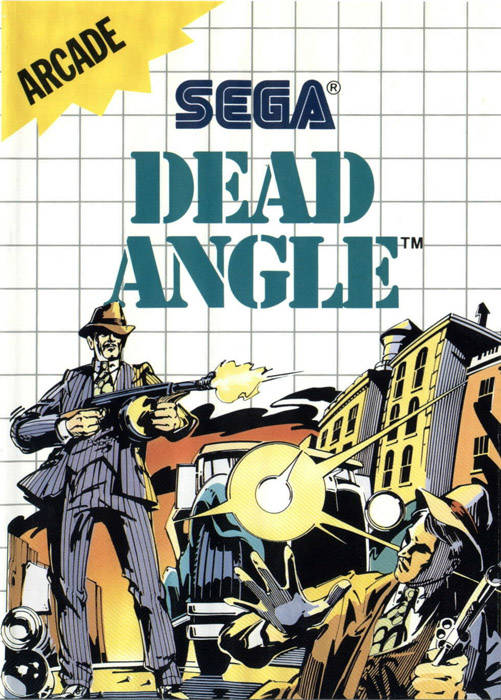
PLAYERS: 1
PUBLISHER: Sega
DEVELOPER: Seibu Kaihatsu (port by Sega)
GENRE: Shooter
RELEASE DATE: 1990 (US), 01/90 (EU)
Dead Angle gives gangster shooting a bad name. For starters, the game feels like it should have Light Phaser support, but it doesn’t. And without Light Phaser support, that means you control the crosshair and shoot with the Master System controller. Typically, this decision would be ok, but you don’t just control the crosshair with the D-pad. You also control a giant silhouette of the main character along with the crosshair. In other words, you can’t move the silhouette without moving the crosshair, and vice-versa. Neat, sure. Technologically amazing for 1989, maybe. Cumbersome, you bet. The needless decision to tie the crosshair and the silhouette together, along with the silhouette’s all-encompassing presence, weighs down what should be a straightforward gangster bloodbath.
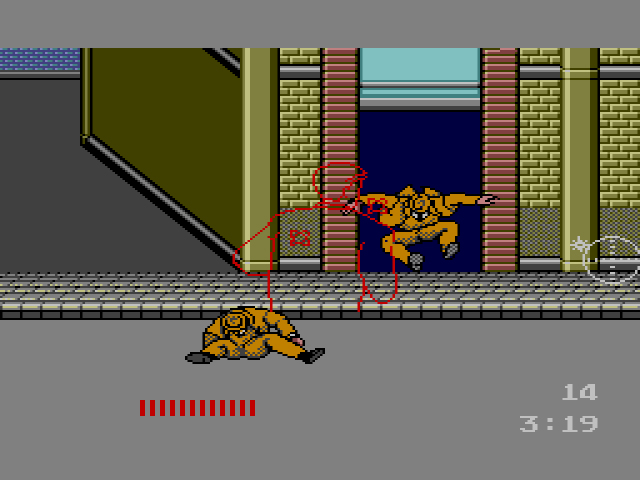
You play as George Phoenix, a private detective whose girlfriend has been stolen by the mob boss, Robert King. Naturally, Phoenix wants to get her back, but King’s legions of zoot-suited yahoos have other plans. Each level takes place in a different locale – streets of Napoli, New York hotel, etc – and gives you a specific amount of thugs to kill. Dwindle down their numbers with your standard gun or find a tommy gun upgrade and give ’em the true definition of “what for.”
The color of the gangster’s suit dictates both their movement and how strong they are. For example, in level 2, when the red-suited gangsters’ bullets hit you, it counts as two hits instead of one; thankfully, each gangster only needs one bullet from you to call it a life. Once you’ve gotten their numbers down to bupkis, the mob boss of that region will emerge, full guns blazing. A few hits (they’re swarthier than the others), and they’re black coffee with toast.
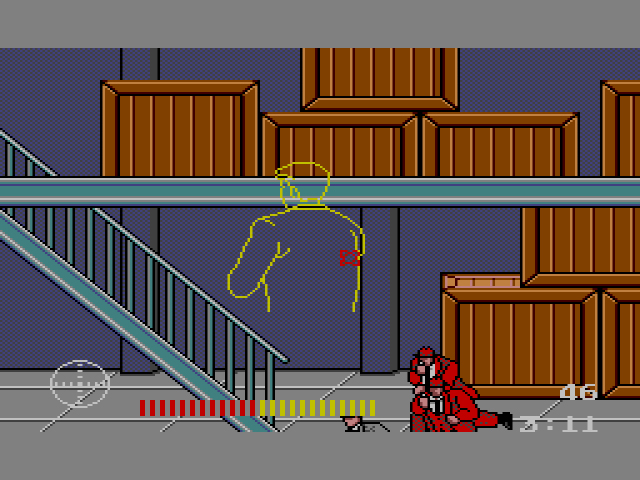
As previously mentioned, you control both a silhouette of Mr. Phoenix and the crosshair at the same time. Your silhouette is large and takes up a good portion of the middle of the screen; viewed from a different (dead) angle, Mr. Phoenix looks like a monster ghost that’s terrorizing the poor gangsters. If Phoenix gets shot three times anywhere in his silhouette, he’ll say “Ouch!” in a particularly unmasculine voice and die. To counteract the gangster’s sheer numbers and advanced mobility, you are able to float above the ground and terrorize your victims from above. But because the crosshair and the silhouette are both connected to the same control input, and because the gangsters are constantly moving and shooting, you will always have to move around the screen and shoot at random to not get hit.
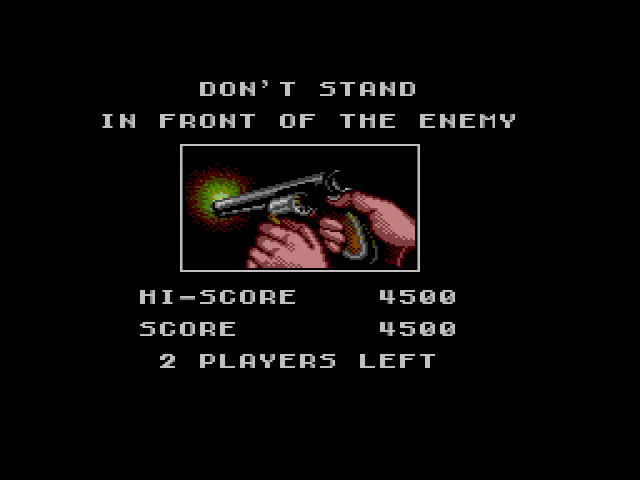
Dead Angle‘s style might be distinct, but it also causes some of the worst slowdown I’ve ever seen on the Master System. The combination of Phoenix’s large silhouette with the gangsters that leap and frolic across the screen brings stuttering in ways not seen since Space Harrier 3D. With an awful framerate comes general confusion. You’ll never know when or how you were shot, especially if your silhouette doesn’t appear to be in the gangsters’ line of fire.
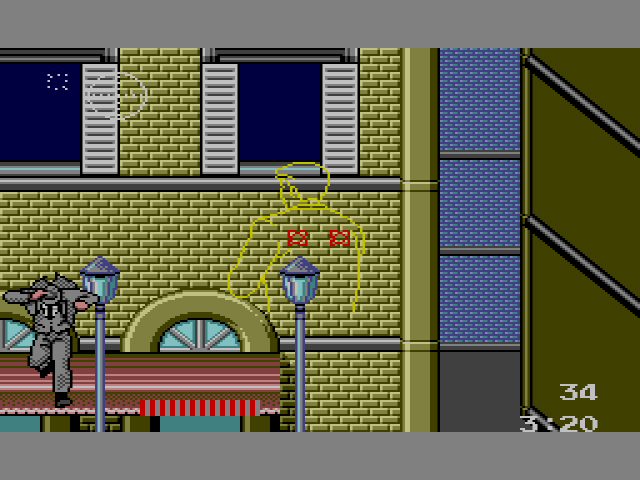
Thanks to the slowdown and the lack of lives/continues, Dead Angle‘s five levels are as intimidating as a gangster’s steely-eyed gaze. The only way to stay alive is to never stop moving your silhouette and fire constantly. But if you keep moving and firing constantly while the gangsters are doing likewise, you have a choppy mess of a shooter that’s ambition is its downfall. If you really have an urge to shoot gangsters, check out Sega’s Gangster Town. The latter shows that class, style, and top-notch level design beat ambition any day.
D+

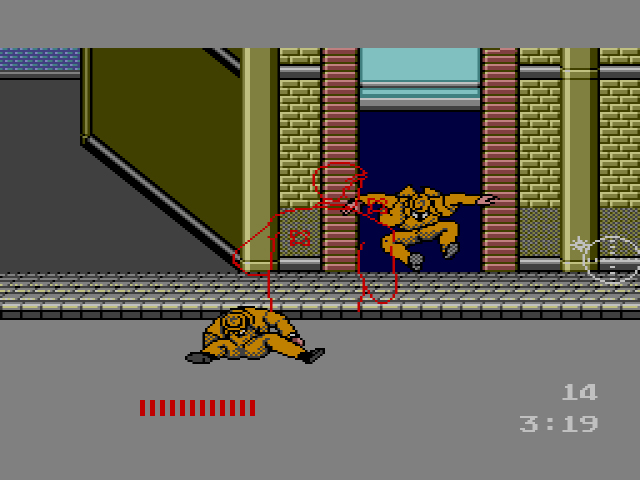
11 replies on “Dead Angle (Master System, 1990)”
I wanted to post and let you know I love your site. I check it everyday to see what you’re reviewing next. As for this game, it seems really similar to the SNES game, Wild Guns. The gameplay of controlling the character and crosshair at the same time is done in that game as well, although it seems like Wild Guns does it much better. If you want to see a game do this type of game correctly, I recommend checking it out. It’s really expensive though so a digital download of some sort is recommended.
Hey thanks Rev! Both for the compliment and for the game recommendation.
I remember seeing Wild Guns as a kid back in the day, but I never rented it. I’ll have to check it out!
This game is basis lay part of a trilogy by Seibu Kaihatsu. The first game was Empire City 1941 which was released on the NES and largely had similar game play to this. Dead Angle is basically a sequel. The Third game is Dynamite Duke. Which came out here on the Genesis. I think all three were arcade games. All three share the same behind the person crosshairs gameplay with slightly different gameplay mechanics. Dynamite Duke in my opinion is the best and most interesting of the 3. It also includes Merle attack gameplay and some cool boss fights.
I knew Empire City 1941 was the prequel, but didn’t know about Dynamite Duke. Dead Angle would have probably played smoother if it had been ported to the Mega Drive instead of the Master System.
“Dynamite Duke” was also released on the Master System!
Woah, that it was! In Europe only.
http://segaretro.org/Dynamite_Duke
I can see why the programmers may have thought the silhouette idea was a good one. There is a certain sense of logic to it. When playing other crosshair-shooters such as the non-phaser version of Assault City (which is pretty good and actually holds the distinction of being the first game I completed on the SMS) whenever an enemy fires at the screen because you haven’t dispatched him quick enough you take a hit. The silhouette, in theory, increases the realism factor and makes it tougher on your digital enemies. Unfortunately, as with a lot in Sega’s history, the theory was let down by poor execution.
I’ve heard the Dead Angle arcade game is far superior to the Master System port, and I believe it.
It has really nice graphics at least.
A shooter like this where you can’t use a gun peripheral is like a racing game that doesn’t allow you to play using a driving peripheral. Or an analogy that starts out strong but sort of peters out at the end . . .
This game looks very nice for a Master System game. Unfortunately the arcade big brother was so far ahead of this game and I find it plays much better also. I never really could get into the home version of this game.
Thanks for the review.